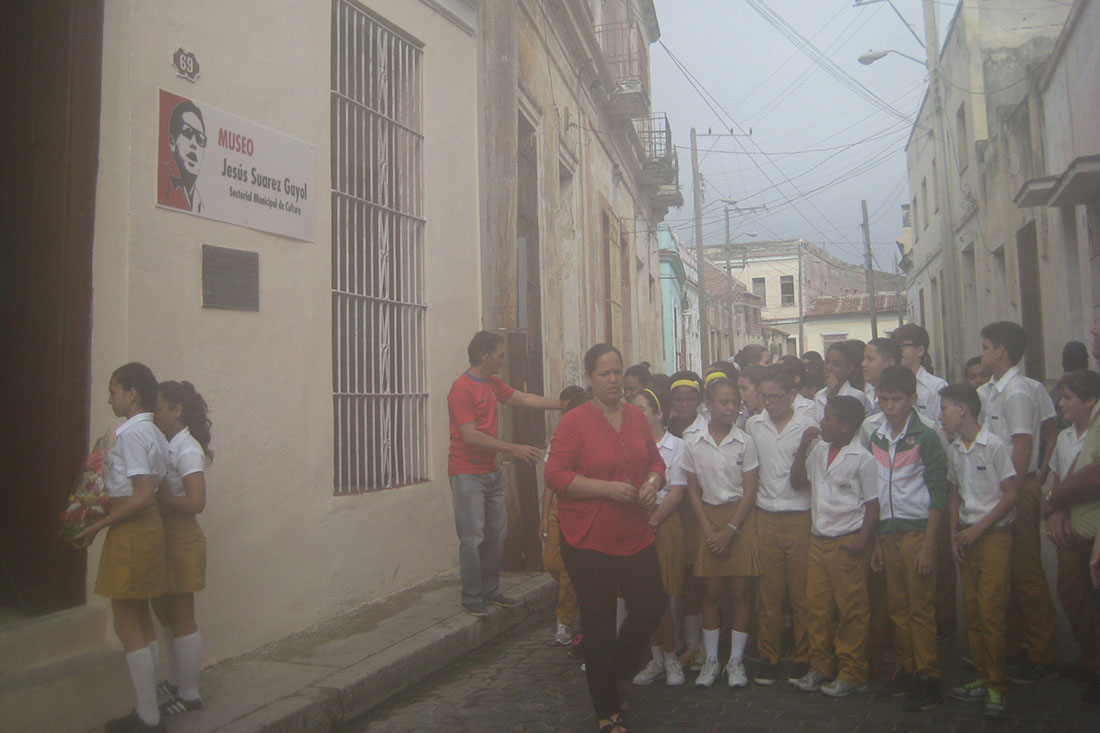If we walk along Republic Street, almost at the end, we find the colonial mansion numbered 69; for many it may pass for another of the buildings from the 30s of the last century, but if we stop and look carefully, we will discover great stories kept within its walls.
There lived during his adolescence and period of greatest clandestine work, the student leader Jesús Suárez Gayol, who later became the tireless and tenacious revolutionary, anti-imperialist and internationalist fighter: “el Rubio” of Che’s Guerrilla in Bolivia.
His mother, Mrs. Aurora Gayo, being a widow, moved to Camagüey so that the son could continue his studies, in the mansion that today houses the Museum dedicated to the student struggles in Camagüey in the period of 1952-1958, he set up a guest house, to justify its mission of offering shelter to the young revolutionaries who were already gathering to conspire against the abusive Batista regime.
The key role that the student body played in this stage is today recreated in the three rooms, which hosted secret meetings and hid the wounded.
Going back in time
To understand what happened when the doors of that dwelling were closed, I am going to share details of a meeting, which we achieved in February 2021, with a friend and schoolmate of Suarez Gayol, Agustín Días Hernández, affectionately known as Chichi.
A few months after this meeting Chichi died, his family was happy for him because we got his testimony, he put a lot of effort into the talk and I assure you that it was very pleasant.
Chichi’s memories
Without our emotions abandoning our meeting in the living room of the house, Chichi cleared his throat and with a look of sadness and longing, he returned to being that restless young man and we traveled to the year 1958…
Gayol was a young man like any of my time, happy, a basketball enthusiast, of doing evil things, an amorous man, he even had two girlfriends at the same time and found himself in trouble, he says with a mischievous smile.
We were like brothers, I used to go a lot to his house where the student museum is today and his mother treated us with affection, she and some of her guests participated in our meetings, there we prepared the sabotage actions that we would execute in the next outings.
Our chief of action at the institute was Gayol and his liaison with the higher level on the July 26th movement was Cándido González, but he was heavily booked by the police and we had to be very careful to get together, the guest house misled Batista’s henchmen, because the entry and exit of people in a lodging like this was normal.
An action
One night meeting in the mansion, we agreed on an action for the next day in the vicinity of the railway workshops, there in the Garrido neighborhood, “I was a stapler” to puncture the enemy’s cars and we had set fire to a payment booth from the government and they arrested me, I already had a history of being a troublemaker with the DTI and they recognized me, but they couldn’t prove anything to me, so when I left I went to Santiago de Cuba.
I returned on November 1st, 1958, there they arrested me again, they sentenced me to a year in prison, when the revolution triumphed I was still in prison, that was the happiest day of my life, emotion and joy moisten their eyes again.
After the triumph, the reunion
Chichi stopped seeing his partner and brother in the fight, both continued the fight in different ways, with the triumph of the Revolution they sent him to Moa to start up the nickel plant, the first productions of Cuban mineral were achieved under his supervision, as shift manager of the largest plant, where in 1963 he received a pleasant visit.
There, the town was going to be inaugurated and an act with the mining community would take place. For the occasion, El Che and his brother in strugle, Jesús Suárez Gayol, came to preside over the meeting.
When they met they merged into a hug, full of feelings and joys, once alone, Gayol proposed to Chichi to go with him to the capital as his office manager, but the plant needed his work and he could not accept the invitation.
Little did the brothers imagine that this would be their last meeting, since soon the blond would leave with El Che’s guerrillas for Bolivia. In 1966 he became the first Cuban martyr of the Bolivian guerrilla.
Synthesis
The Jesús Suárez Gayol Student Museum has a valuable collection of objects, documents and original photographs of the martyrs linked to the Camagüey student body, donated to the institution by relatives, friends and people close to them.
Today as we dust off these experiences of the young Agustín, linked to his companion of ideals Jesús Suárez Gayol, we not only recall the student struggles in the city, but also leave the doors of the mansion open, to listen to secrets and actions born from the hearts of those boys, who contributed so much to the freedom of Cuba.
Translated by: Aileen Álvarez García






